| 1 | Red-headed krait |
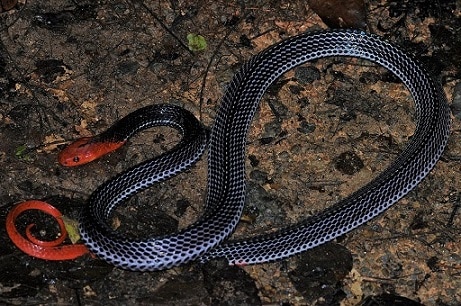
A 150cm snake (maximum 207cm) found mainly in lowland rainforests. Red-headed kraits (Bungarus flaviceps) aren’t found near Bangkok, but are abundant in the southern regions of Thailand, plus Malaysia and Sumatra. Instead of hilly forests, red-headed kraits prefer lower areas, usually from 0 to 900 metres in elevation, with an absolute record of 1200 metres. As measured by the LD50 scale, this species has one of the most toxic snake venoms on earth.
The official LD50 score is 0.32mg, which easily outstrips their cousin the banded krait (1.2mg), and even a king cobra (0.9mg). This venom is primarily neurotoxic, causing moderate to severe paralysis. A bite from a red-headed krait can freeze all muscles and connected tendons, leaving you a prisoner, hoping desperately that the doctors busying over you succeed in saving your life.
Fortunately, they usually do, as Bungarus flaviceps bites are easily treated with antivenom. Their venom profile is similar to Thailand’s blue krait (Bungarus candidus), meaning that the country’s main Bungarus krait antivenom works almost as well.
The cause of death from Bungarus flaviceps, if it occurred, would be respiratory paralysis, as the commanding signals from the brain to the lungs totally shut down. This venomous snake moves by night, and is less inclined to bite during daylight. Its red head probably evolved as a warning signal, alerting birds and great apes to its presence.
| 2 | Kuri buri pitviper |
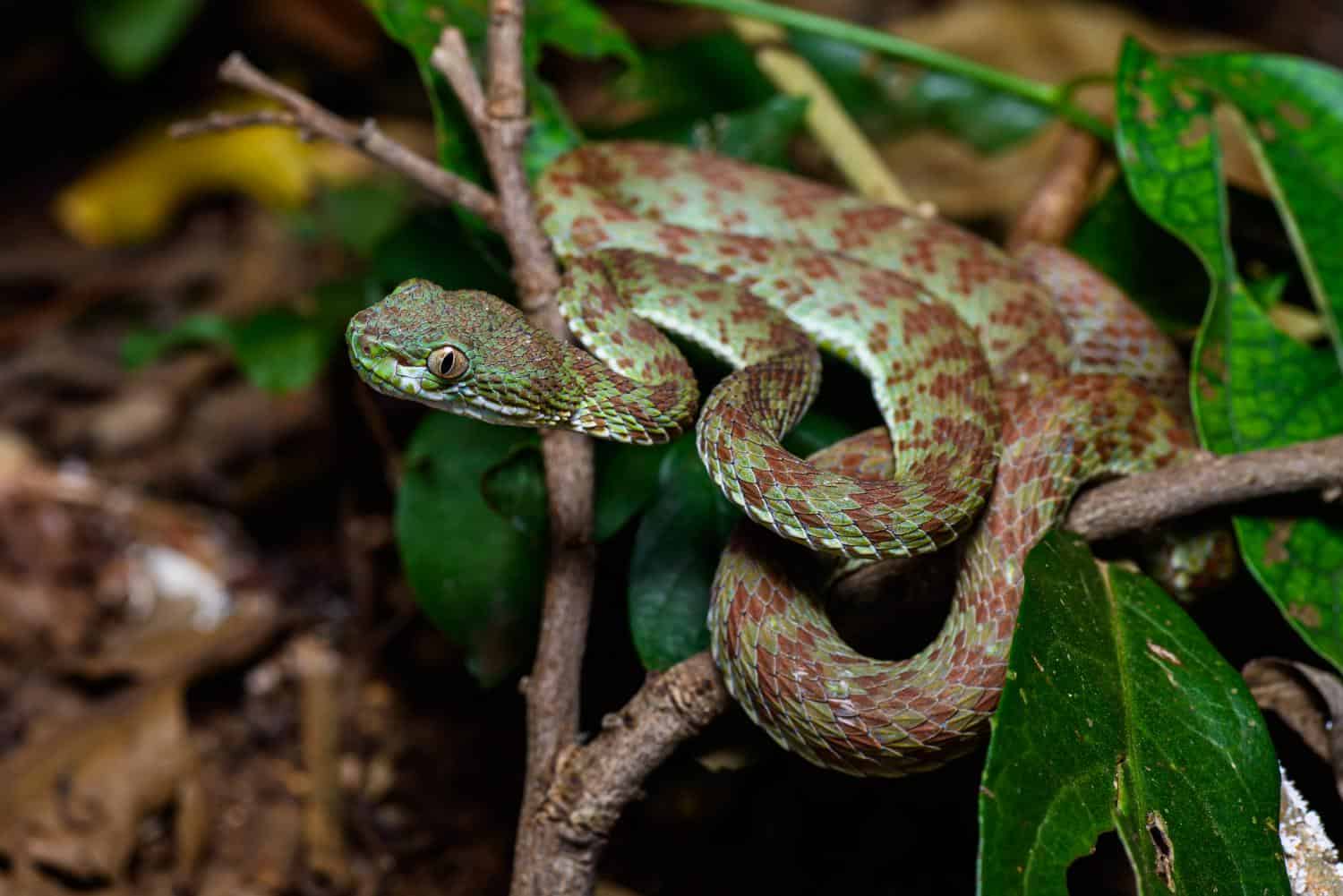
An all new venomous snake discovered in 2021, creating yet another part of Thailand that you have to tread carefully in. The Kui Buri pitviper (Trimeresurus kuiburi) resides in a small region of Prachuap Khiri Khan province, in central southern Thailand. This discovery brought the total number of Trimeresurus pitvipers in Thailand to 14, which has since grown to 18 as of December 2024.
Compared to other members in Thailand, the Kui Buri pitviper has red-purple stripes on a green background, combined with a pale green belly with very few spots, and a small white line below the eye. Its tongue is approximately the colour of a human being’s gums. Males have white spots down their spine, which females lack.
The Kui Buri pitviper is a fairly small snake, rests on branches for most of the day, and has a gold eye with green tinges. Being so new, we don’t have an all-time length record yet, but in the initial study, the snakes the scientists collected measured 37-52cm.
Every known Trimeresurus pitviper member is venomous, but the exact makeup of this species’ toxin profile remains to be seen. The family tends to shred through skin tissue, rather than be neurotoxic like a coral snake. Its closest relative was found to be the large-eyed pitviper (Trimersurus macrops), whose venom causes mass necrosis and has a half life in the body of 14 days. Time will tell what dark skills the Kui Buri pitviper possesses.
| 3 | Malaysian blue coral snake |
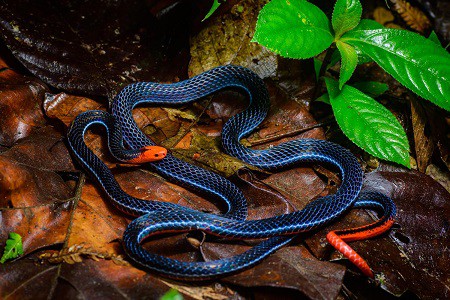
An extremely dangerous snake, which you could probably survive walking past, but would be virtually guaranteed death from if you touched. The Malaysian blue coral snake (Calliophis bivirgatus) reaches a confirmed record of 185cm, and is found across a swathe of southern Thailand. This species has incredibly long venom glands, stretching almost 40% of the way down its body, and its venom has several unique toxins.
The first is maticotoxin, making up 30% of the venom, a cytotoxin which ruptures the membranes and walls of skin cells. The second is the most potent – calliotoxin, which causes almost instant paralysis, sometimes within 30 seconds. It achieves this via massive stimulation of the body’s sodium channels, causing overactivation of all neurons simultaneously.
Being so unique, calliotoxin has a unique danger – no known antidote. The Malaysian blue coral snake mainly feeds on other snakes, which is a dangerous menu. Hence, it has evolved to have one of the most rapidly paralysing venoms in the world. Two deaths are on record for Calliophis bivirgatus: a Malaysian child who died within 2 hours in 1956, and a showering Singapore man who died within 5 minutes after being bitten on the toe.
Fortunately, this snake is relatively docile and calm. Calliophis bivirgatus lives mainly in forests, and has secretive instincts, preferring to hide within leaf litter on the forest floor. Its first wall of defence is tucking its head deep within forest mulch, to keep its brain safe. The second is flashing its neon red colours as a warning, and biting people comes a distant third.
| 4 | King cobra |
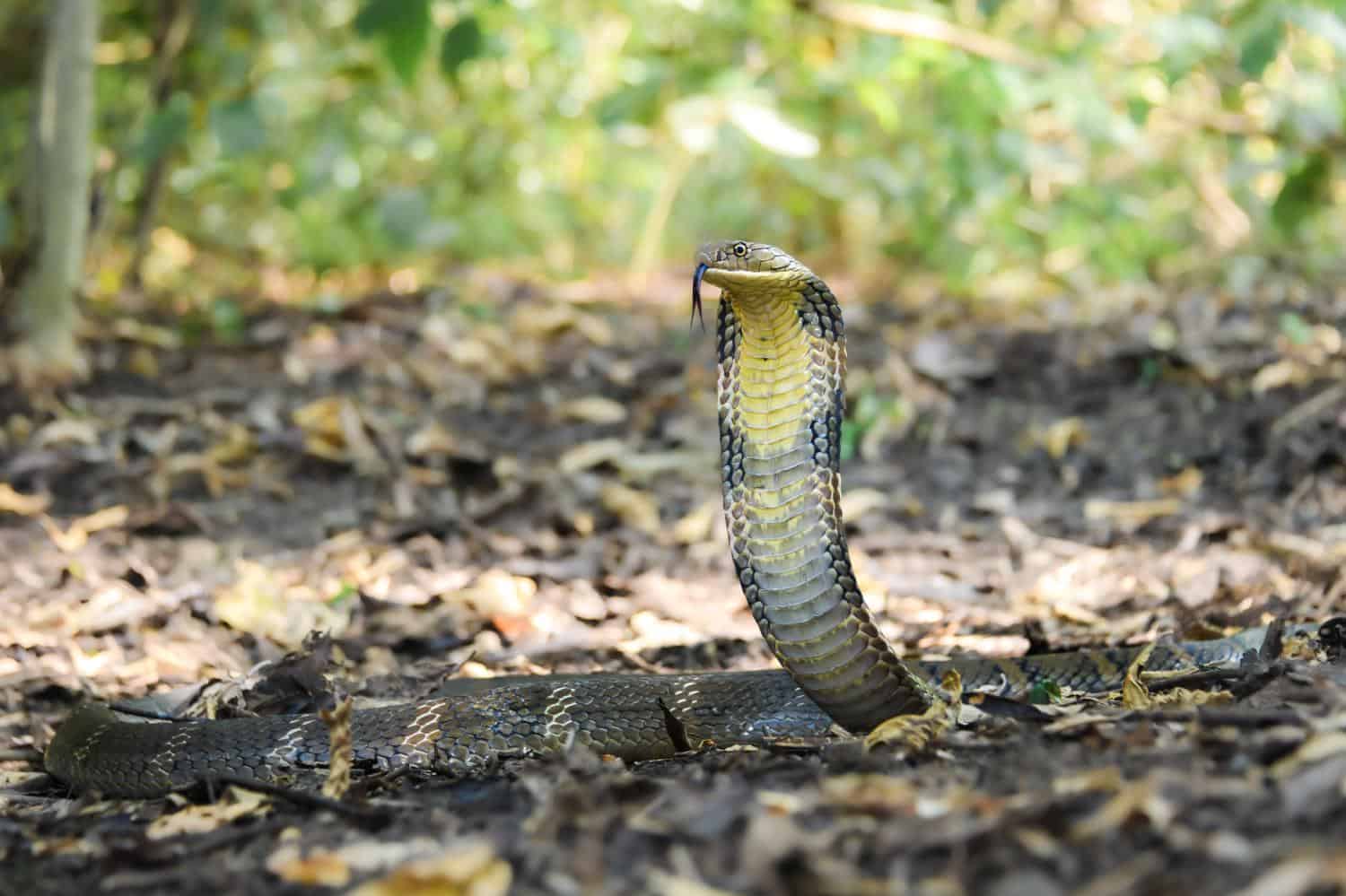
One of the world’s most notorious snakes, the king cobra occupies virtually all of Thailand. There’s barely an inch of the country where they can’t rear their ugly head. Their venom is primarily neurotoxic, with a side helping of skin tissue destruction, and its bite can deliver 420mg of venom in seconds. At a confirmed wild record of 5.85 metres, this is the longest venomous snake surviving.
King cobras are rarely found in urban areas. They’re most common in Thailand’s forested and semi-forested regions, but also appear in agricultural areas under mankind’s control. They even slither down irrigation canals directly adjacent to fields, growing closer and closer menacingly.
This is a snake which could hunt you down, as a study from northern Thailand’s Sakaerat Biosphere Reserve found that king cobras move 183 metres in an average day. However, despite the terror they inspire, king cobra bites are far less common in Thailand than from the smaller monocled cobra or Siamese spitting cobra (see our first article).
Another study discovered geographical variation in the venom. This landed in Thailand’s favour, as the venom of the local king cobras was less lethal than those from China and Indonesia. Thai king cobra bites were also easier to treat with antivenom. There’s even a king cobra village in Thailand called Ban Khok Sa-nga, where they’re kept as pets, with daily ceremonial rituals held.
| 5 | Eastern Russell’s viper |
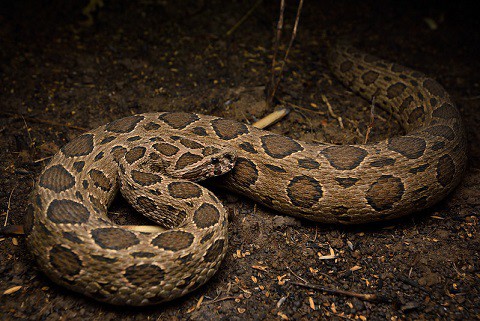
This was formerly a subspecies of the Russell’s viper (Daboia russelli), the Indian horror which kills an estimated 20,000 people per year (possibly the most of any snake). In 2007, the Burmese and Thai versions were separated into their own species: Daboia siamensis.
The eastern Russell’s viper averages at 100cm, and differs in appearance by having smaller dark spots between the large blotches, rather than empty spaces. It’s mainly concentrated in central Thailand, including the outskirts of Bangkok. Daboia siamensis is smaller than its Indian cousin, and currently has an all-time record of 127cm.
Is the venom as horrifying as its western big brother? All signs suggest yes. In a 2021 report, a snake handler was inspecting the mouth and nose of a Daboia siamensis for signs of infection, when he received an ungrateful bite to the finger. The victim developed throbbing pain and swelling within 30 minutes, along with neurotoxic symptoms such as numb ankles and difficulty walking.
He also experienced kidney damage, which was telling, as kidney failure is the main cause of death with the Indian Russell’s viper. Clearly, the two have a fairly similar venom. The patient was walloped with 8 vials of antivenom, including 4 vials within one hour, yet still showed symptoms 8 days later.
| 6 | Black-banded keelback |
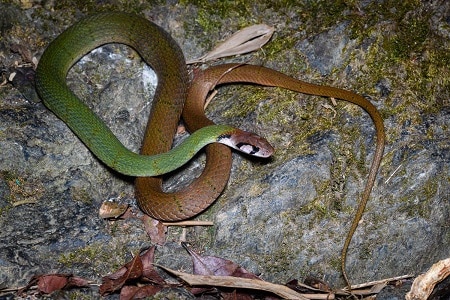
This rare Thai snake looks like a 5 year old’s first painting project at school. Rhabdophis nigrocinctus belongs to the same family as the more common red-necked keelback (see our first article). Little is known except that their saliva contains a potent venom. If they’re anything like their cousin, they’ll hold onto their victims and chew repeatedly to force the venom in.
Rhabdophis nigrocinctus measures up to 95cm, and is far from a Bangkok citizen. They’re found all over Thailand, but only near mountain streams within deep forests, at elevations of 600-1000 metres. With such an explosion of colour in these tropical forests, Rhabdophis nigrocinctus blends in superbly. It’s rare for humans to encounter this venomous snake, but it still wouldn’t be smart to let your hair down after a picnic and start splashing around in a random forest stream, or a scenic Thai lagoon.
The black-banded keelback is an unknown quantity; it could be gentler than its red-necked keelback cousin, but it could be far worse. They’re rare within their territory, yet are spread across the whole of Thailand, bar the far south. Black-banded keelbacks cling closely to forests, and cannot cope when loggers move in.
| 7 | Guo’s green pit viper |
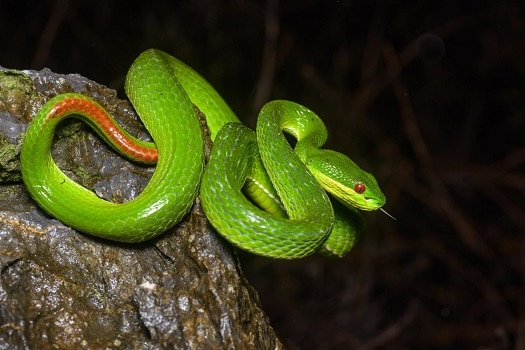
Another newly discovered Thai pitviper, which became an official species in 2020: Trimeresurus guoi. Guo’s pitviper resides in northern Thailand, sharing a swathe of territory with Pope’s pitviper (Trimeresurus popeiorum). The two differ significantly in habitat, as Pope’s pitviper is significantly less flexible, restricting itself to forests and vanishing when humans encroach. Meanwhile, the new Guo’s pitviper was happy to slither around agricultural and deforested areas as well.
From a distance, Guo’s pitviper looks like the same old sea of greenness, yet they have a far redder tail than most Trimeresurus pitvipers. Compared to white-lipped pitvipers (easily the most common member), they have redder eyes, a friendlier face, and no sign of the namesake white line.
Trimeresurus guoi is venomous, but there isn’t a single morsel of knowledge on the exact properties. They range from lowlands to 1400 metres above sea level, and often inhabit drier forests. Aside from its red tail, this is a smoothly green snake, with few intricate patterns. Guo’s green pitvipers average at 50-70cm, but the largest so far reached 89cm.
| 8 | Banded sea krait |
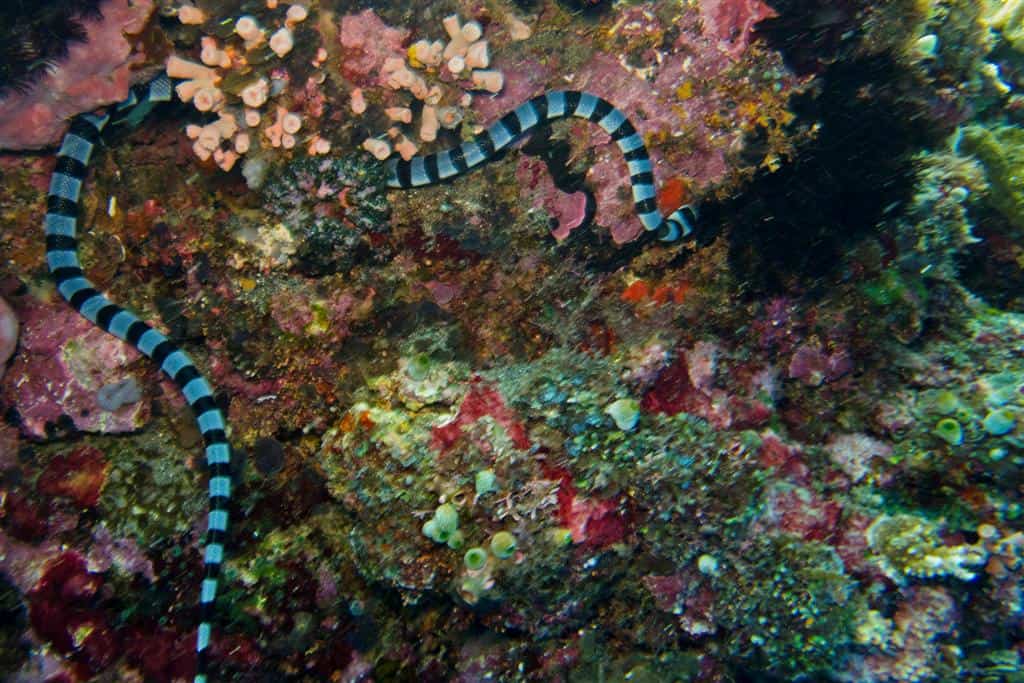
A severely neurotoxic sea snake, which averages at 80-140cm, and reaches a record of 152.5cm. This species is notorious for gathering in vast numbers along the rocky shores off Phuket, Thailand’s scenic tourist city. Take a scuba diving excursion in Phuket and you’re almost guaranteed to see them, but luckily, this snake has such small fangs that it’s incapable of biting through a standard black wetsuit.
The banded sea krait (Laticauda colubrina) has an LD50 toxicity rating of 0.4mg, which beats a king cobra. Nai Yang Beach near Phuket International Airport is a particular hub for them, as are the scenic Phi Phi Islands a few miles off shore. Shark Point lies inbetween, and is an infamous gathering zone for leopard sharks, but the banded sea kraits here are just as abundant. This is one of Phuket’s most popular tourist diving sights.
Staying calm and swimming right past a banded sea krait will prevent most mishaps, as they’re very docile. Deaths that do happen are usually due to fishing trawlers scooping them up in nets by accident, emptying the contents, and suffering a nasty shock as a snake latches onto their finger.
Banded sea kraits are mostly found on the west coast of southern Thailand. For example, they’re far rarer near Pattaya further east.
| 9 | Black-headed catsnake |
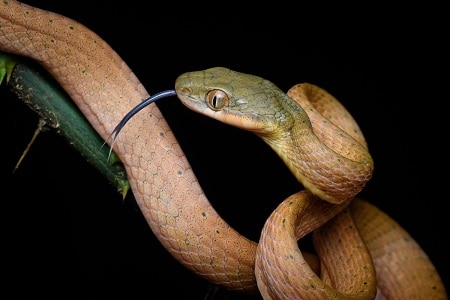
A 100-150cm species (maximum 175cm) which occupies most of Thailand’s south, skipping Bangkok and Pattaya, but appearing across all areas of the thin southern peninsular. The black-headed catsnake (Boiga nigriceps) dwells in forests, sticking close to water sources within. They’re often seen dangling down from a thin tree branch, searching for frogs.
Most catsnakes (Boiga genus) possess a weak venom injected by their rear fangs, but the black-headed catsnake (Boiga nigriceps) may have reached the next level. Like a black mamba, (albeit much weaker), its venom has gene transcripts for three-finger toxins, a type of neurotoxin. Boiga nigriceps apparently possesses post-synaptic neurotoxins, which prevent acetylcholine brain signals from being received in muscle cells. In lab experiments, these were able to reduce the twitching of skeletal muscle tissue.
In the real world, this would kickstart the chain of events that leads to paralysis. According to a 2004 study, the potency of Boiga nigriceps’ neurotoxins was comparable to those of the Australian tiger snake.
Consequently, black-headed catsnakes are one of the more dangerous Boiga catsnake members, but they still have to position their head awkwardly to pierce their rear fangs through skin. They’re reluctant to bite full stop, normally beginning with a series of mock lunges rather than going straight for death dealership.
| 10 | Small-spotted coral snake |
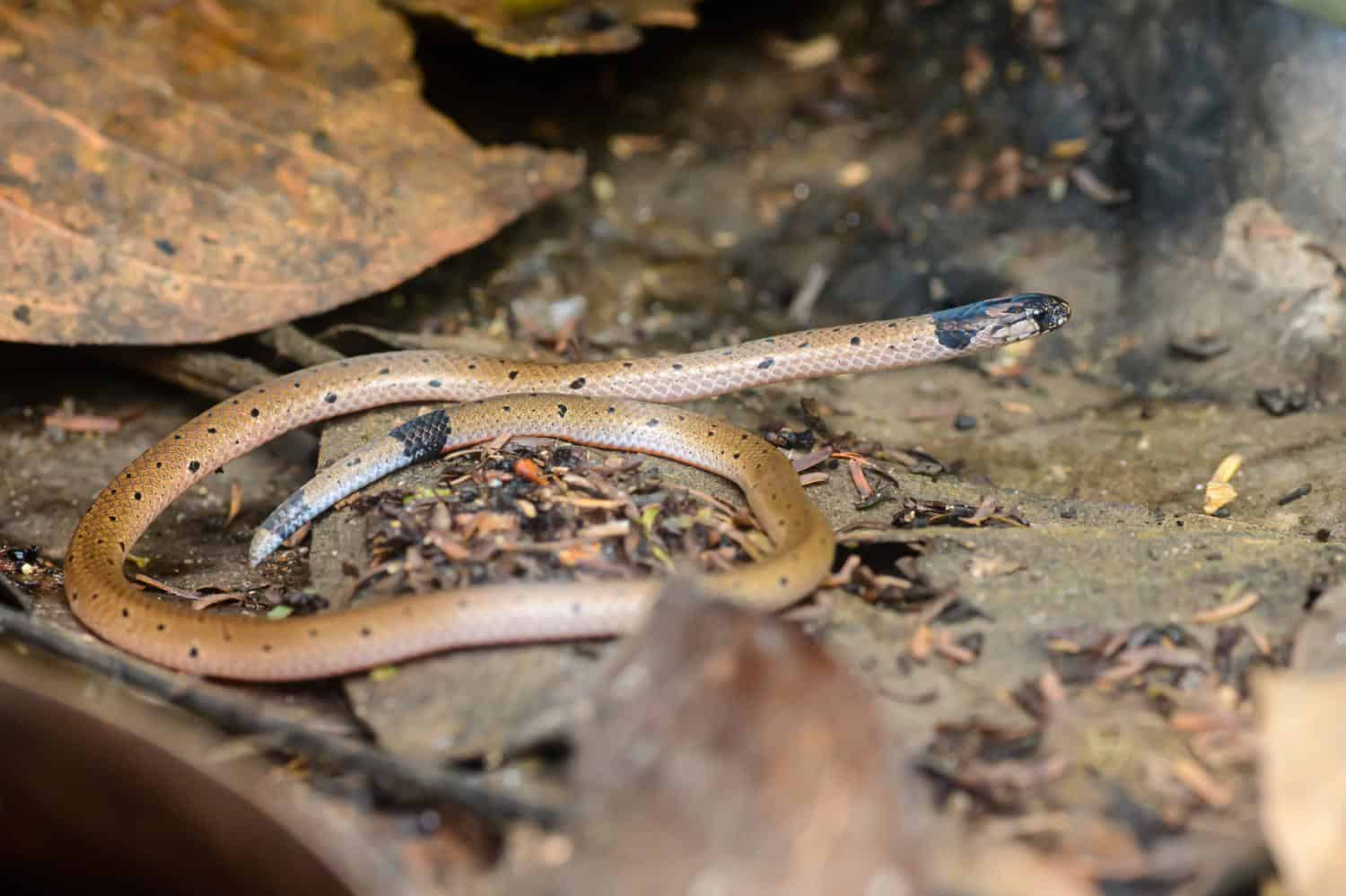
The small-spotted coral snake (Calliophis maculiceps) lives in all regions of Thailand, often appearing in gardens curled up in potted plants, or hidden within layers of leaf litter. It belongs to the same Calliophis genus as the Malaysian blue coral snake, but is far smaller, at a maximum of just 50cm. It also lacks the freakish torrent of venom, and the notoriously long venom glands covering 40% of its body.
The Calliophis genus is divided into long-glanded and short-glanded snakes, and this species belongs to the latter. However, it’s still capable of causing body-wide symptoms.
Bites are rare, and the first proper report ever happened on October 11th 2017, when a scientist was bitten on the right index finger after picking up a Calliophis maculiceps at the Sakaerat Environmental Research Station in northeast Thailand. The snake was slithering around on some bathroom tiles, and within the hour, the scientist’s finger was swollen and throbbing. Soon, a strange numbness appeared in his chin and cheeks.
By 3 hours post bite, his arm and elbow were also aching painfully. The man developed an uncomfortable feeling in his throat, which made it difficult to swallow. Most unusually, a hardened callus appeared around the fang marks over two weeks after the bite. This snake was a juvenile measuring just 20cm, so an adult measuring 40cm could inject more venom and much more danger.
Small-spotted coral snakes are still mysterious in many ways. Their diet is barely researched, though is believed to consist of tiny snakes like blind snakes.
